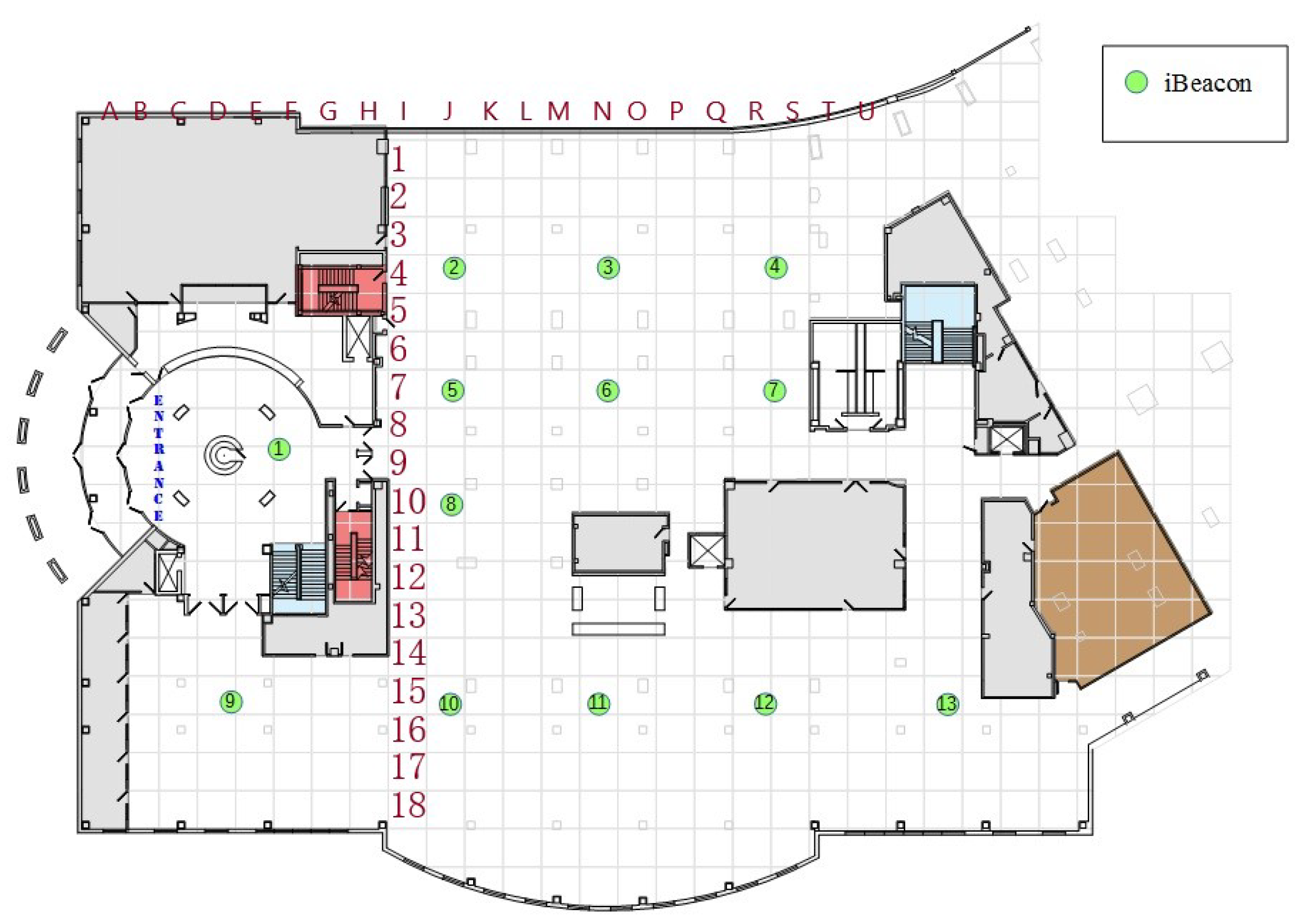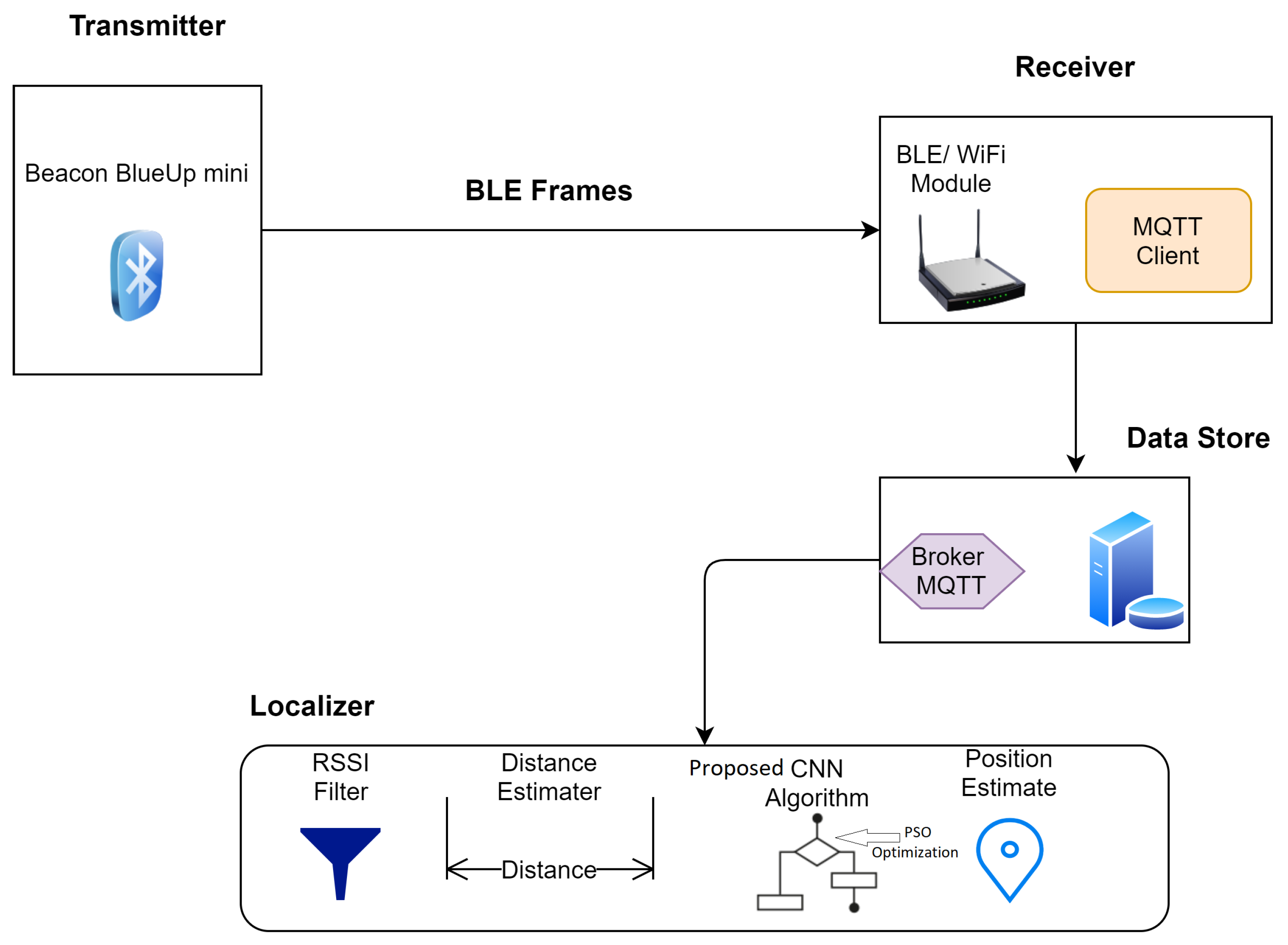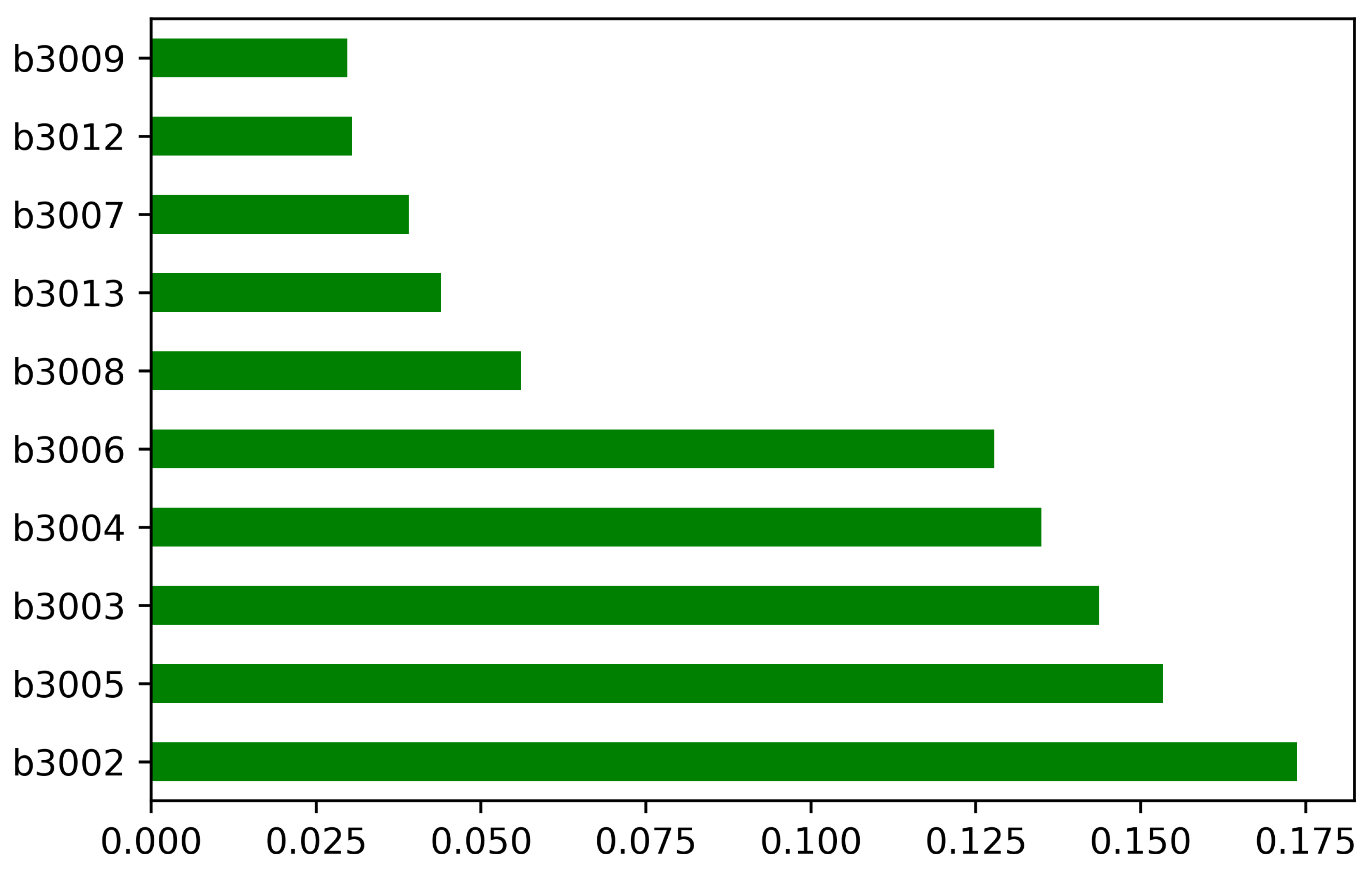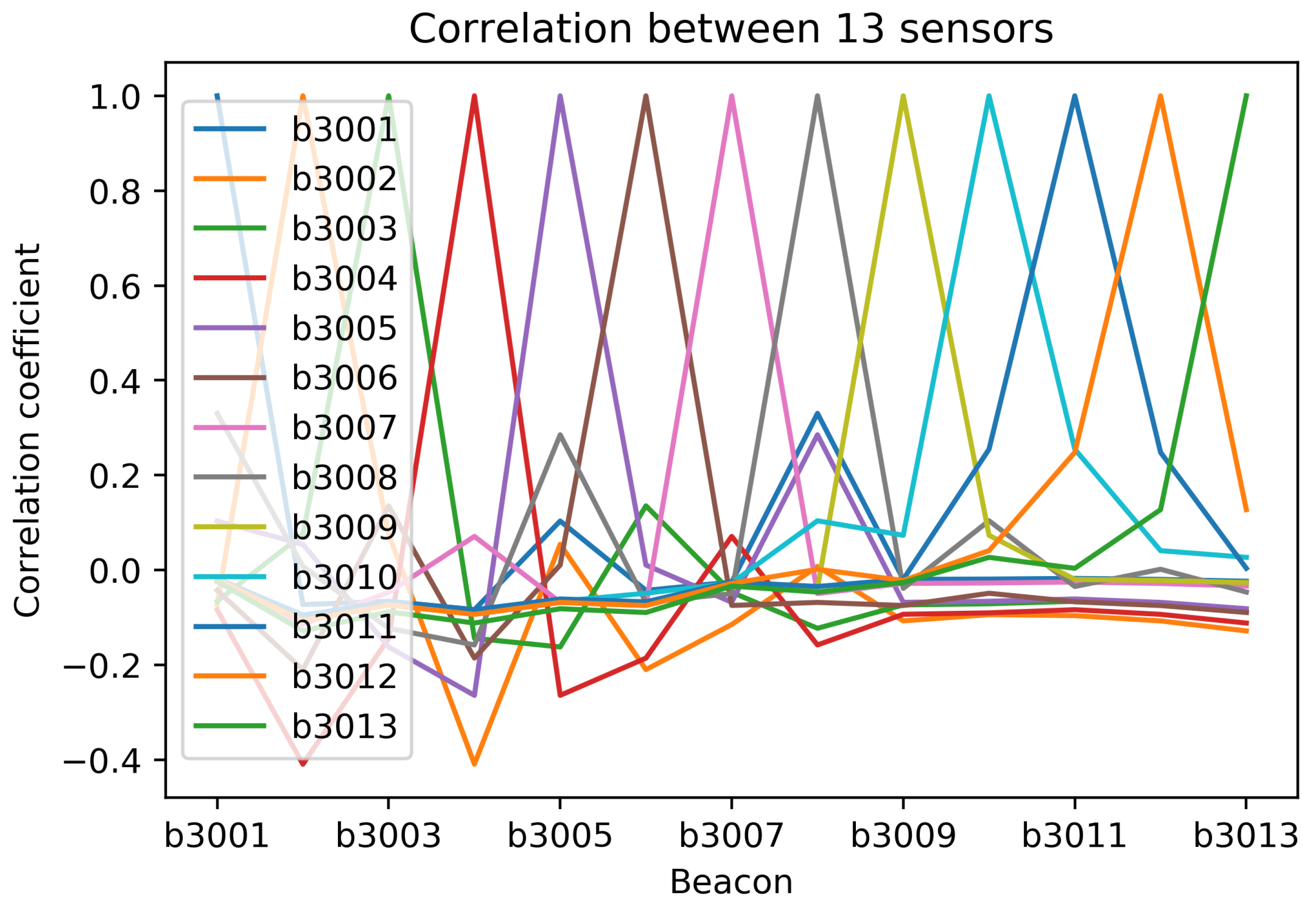Optimized CNNs to Indoor Localization through BLE Sensors Using Improved PSO
Abstract
1. Introduction
2. Related Work
3. Material and Methods
3.1. Locating Transmitters
- Immediate: This state indicates the close presence of a device to beacon.
- Near: Indicates that the device is 1–3 m away from the beacon without any barrier.
- Far: It indicates low confidence due to greater distance and the presence of several barriers between the device and beacon.
- Unknown: It indicates that transmitter proximity cannot be detected.
3.2. System Architecture
Proposed Framework
| Algorithm 1 Pseudo Code for basic localization system. |
| Require: Record RSSI signals and number of beacons Ensure: Sensor with rich RSSI value
|
| Algorithm 2 Pseudo Code for proposed indoor positioning |
| Require: Record RSSI signals and number of beacons Ensure: Sensor with rich RSSI value
|
4. Results and Discussion
4.1. BLE Signal Analysis
4.2. Localization Results
4.3. Analysis
5. Conclusions
Author Contributions
Funding
Acknowledgments
Conflicts of Interest
References
- Alhakbani, N.; Hassan, M.M.; Ykhlef, M.; Fortino, G. An efficient event matching system for semantic smart data in the Internet of Things (IoT) environment. Future Gener. Comput. Syst. 2019, 95, 163–174. [Google Scholar] [CrossRef]
- Gartner, I. Gartner Identifies Top 10 Strategic IoT Technologies and Trends. In Proceedings of the Analysts Explore Internet of Things Opportunities and Pitfalls at Gartner Symposium/ITxpo 2018, Barcelona, Spain, 4–8 November 2018. [Google Scholar]
- Gao, J.; Wang, H.; Shen, H. Task Failure Prediction in Cloud Data Centers Using Deep Learning. In Proceedings of the 2019 IEEE International Conference on Big Data (Big Data), Los Angeles, CA, USA, 9–12 December 2019. [Google Scholar]
- Akyildiz, I.; Su, W.; Sankarasubramaniam, Y.; Cayirci, E. A survey on sensor networks. IEEE Commun. Mag. 2002, 40, 102–114. [Google Scholar] [CrossRef]
- Gao, J.; Wang, H.; Shen, H. Smartly Handling Renewable Energy Instability in Supporting A Cloud Datacenter. In Proceedings of the 2020 IEEE International Parallel and Distributed Processing Symposium (IPDPS), New Orleans, LA, USA, 18–22 May 2020. [Google Scholar]
- Malhotra, S.; Jordan, D.; Shortliffe, E.; Patel, V.L. Workflow modeling in critical care: Piecing together your own puzzle. J. Biomed. Inform. 2007, 40, 81–92. [Google Scholar] [CrossRef]
- Frisby, J.; Smith, V.; Traub, S.; Patel, V.L. Contextual Computing: A Bluetooth based approach for tracking healthcare providers in the emergency room. J. Biomed. Inform. 2017, 65, 97–104. [Google Scholar] [CrossRef] [PubMed]
- Stehlé, J.; Voirin, N.; Barrat, A.; Cattuto, C.; Colizza, V.; Isella, L.; Régis, C.; Pinton, J.F.; Khanafer, N.; den Broeck, W.V.; et al. Simulation of an SEIR infectious disease model on the dynamic contact network of conference attendees. BMC Med. 2011, 9, 87. [Google Scholar] [CrossRef]
- Hornbeck, T.; Naylor, D.; Segre, A.M.; Thomas, G.; Herman, T.; Polgreen, P.M. Using Sensor Networks to Study the Effect of Peripatetic Healthcare Workers on the Spread of Hospital-Associated Infections. J. Infect. Dis. 2012, 206, 1549–1557. [Google Scholar] [CrossRef] [PubMed]
- Vankipuram, M.; Kahol, K.; Cohen, T.; Patel, V.L. Toward automated workflow analysis and visualization in clinical environments. J. Biomed. Inform. 2011, 44, 432–440. [Google Scholar] [CrossRef]
- Deak, G.; Curran, K.; Condell, J. A survey of active and passive indoor localisation systems. Comput. Commun. 2012, 35, 1939–1954. [Google Scholar] [CrossRef]
- Gao, J.; Wang, H.; Shen, H. Machine Learning Based Workload Prediction in Cloud Computing. In Proceedings of the 2020 29th International Conference on Computer Communications and Networks (ICCCN), Honolulu, HI, USA, 3–6 August 2020. [Google Scholar]
- Lymberopoulos, D.; Liu, J.; Yang, X.; Choudhury, R.R.; Handziski, V.; Sen, S. A realistic evaluation and comparison of indoor location technologies. In Proceedings of the 14th International Conference on Information Processing in Sensor Networks-IPSN’15, Seattle, WA, USA, 14–16 April 2015; ACM Press: New York, NY, USA, 2015. [Google Scholar]
- Jain, A.K. Richard C. Dubes. Algorithms for Clustering Data. J. Classif. 1989, 6, 126–128. [Google Scholar]
- Lieckfeldt, D.; You, J.; Timmermann, D. Exploiting rf-scatter: Human localization with bistatic passive uhf rfid-systems. In Proceedings of the 2009 IEEE International Conference on Wireless and Mobile Computing, Networking and Communications, Marrakech, Morocco, 12–14 October 2009; pp. 179–184. [Google Scholar]
- Peng, R.; Sichitiu, M.L. Angle of Arrival Localization for Wireless Sensor Networks. In Proceedings of the 2006 3rd Annual IEEE Communications Society on Sensor and Ad Hoc Communications and Networks, Reston, VA, USA, 28 September 2006. [Google Scholar]
- Beritelli, F.; Capizzi, G.; Sciuto, G.L.; Napoli, C.; Scaglione, F. Rainfall Estimation Based on the Intensity of the Received Signal in a LTE/4G Mobile Terminal by Using a Probabilistic Neural Network. IEEE Access 2018, 6, 30865–30873. [Google Scholar] [CrossRef]
- Luna-Perejón, F.; Domínguez-Morales, M.; Gutiérrez-Galán, D.; Civit-Balcells, A. Low-Power Embedded System for Gait Classification Using Neural Networks. J. Low Power Electron. Appl. 2020, 10, 14. [Google Scholar] [CrossRef]
- Rauf, H.T.; Malik, S.; Shoaib, U.; Irfan, M.N.; Lali, M.I. Adaptive inertia weight Bat algorithm with Sugeno-Function fuzzy search. Appl. Soft Comput. 2020, 90, 106159. [Google Scholar] [CrossRef]
- Ferroni, P.; Zanzotto, F.; Riondino, S.; Scarpato, N.; Guadagni, F.; Roselli, M. Breast Cancer Prognosis Using a Machine Learning Approach. Cancers 2019, 11, 328. [Google Scholar] [CrossRef]
- Ferroni, P.; Zanzotto, F.M.; Scarpato, N.; Riondino, S.; Guadagni, F.; Roselli, M. Validation of a Machine Learning Approach for Venous Thromboembolism Risk Prediction in Oncology. Dis. Mark. 2017, 2017, 8781379. [Google Scholar] [CrossRef]
- Matta, M.; Cardarilli, G.C.; Nunzio, L.D.; Fazzolari, R.; Giardino, D.; Nannarelli, A.; Re, M.; Spano, S. A Reinforcement Learning-Based QAM/PSK Symbol Synchronizer. IEEE Access 2019, 7, 124147–124157. [Google Scholar] [CrossRef]
- Rauf, H.T.; Lali, M.I.U.; Zahoor, S.; Shah, S.Z.H.; Rehman, A.U.; Bukhari, S.A.C. Visual features based automated identification of fish species using deep convolutional neural networks. Comput. Electron. Agric. 2019, 167, 105075. [Google Scholar] [CrossRef]
- Rauf, H.T.; Saleem, B.A.; Lali, M.I.U.; Khan, M.A.; Sharif, M.; Bukhari, S.A.C. A citrus fruits and leaves dataset for detection and classification of citrus diseases through machine learning. Data Brief 2019, 26, 104340. [Google Scholar] [CrossRef]
- Spano, S.; Cardarilli, G.C.; Nunzio, L.D.; Fazzolari, R.; Giardino, D.; Matta, M.; Nannarelli, A.; Re, M. An Efficient Hardware Implementation of Reinforcement Learning: The Q-Learning Algorithm. IEEE Access 2019, 7, 186340–186351. [Google Scholar] [CrossRef]
- Cardarilli, G.C.; Nunzio, L.D.; Fazzolari, R.; Nannarelli, A.; Re, M.; Spano, S. $N$ -Dimensional Approximation of Euclidean Distance. IEEE Trans. Circuits Syst. II Express Briefs 2020, 67, 565–569. [Google Scholar] [CrossRef]
- Surian, D.; Kim, V.; Menon, R.; Dunn, A.G.; Sintchenko, V.; Coiera, E. Tracking a moving user in indoor environments using Bluetooth low energy beacons. J. Biomed. Inform. 2019, 98, 103288. [Google Scholar] [CrossRef]
- Giuliano, R.; Cardarilli, G.C.; Cesarini, C.; Nunzio, L.D.; Fallucchi, F.; Fazzolari, R.; Mazzenga, F.; Re, M.; Vizzarri, A. Indoor Localization System Based on Bluetooth Low Energy for Museum Applications. Electronics 2020, 9, 1055. [Google Scholar] [CrossRef]
- Pušnik, M.; Galun, M.; Šumak, B. Improved Bluetooth Low Energy Sensor Detection for Indoor Localization Services. Sensors 2020, 20, 2336. [Google Scholar] [CrossRef]
- Baronti, P.; Barsocchi, P.; Chessa, S.; Mavilia, F.; Palumbo, F. Indoor Bluetooth Low Energy Dataset for Localization, Tracking, Occupancy, and Social Interaction. Sensors 2018, 18, 4462. [Google Scholar] [CrossRef]
- Chen, J.; Zhang, Y.; Xue, W. Unsupervised Indoor Localization Based on Smartphone Sensors, iBeacon and Wi-Fi. Sensors 2018, 18, 1378. [Google Scholar] [CrossRef] [PubMed]
- Alarifi, A.; Al-Salman, A.; Alsaleh, M.; Alnafessah, A.; Al-Hadhrami, S.; Al-Ammar, M.; Al-Khalifa, H. Ultra Wideband Indoor Positioning Technologies: Analysis and Recent Advances. Sensors 2016, 16, 707. [Google Scholar] [CrossRef]
- Zhou, C.; Wang, B. Online Collaborative Localization. IEEE Internet Things J. 2021, 8, 2712–2721. [Google Scholar] [CrossRef]
- Abraha, A.T.; Wang, B. Hierarchical Indoor Localization From Crowdsourced Samples. IEEE Sens. Lett. 2020, 4, 1–4. [Google Scholar] [CrossRef]
- Tian, Y.; Huang, B.; Jia, B.; Zhao, L. Optimizing AP and Beacon Placement in WiFi and BLE hybrid localization. J. Netw. Comput. Appl. 2020, 164, 102673. [Google Scholar] [CrossRef]
- Hernandez, S.M.; Bulut, E. Using perceived direction information for anchorless relative indoor localization. J. Netw. Comput. Appl. 2020, 165, 102714. [Google Scholar] [CrossRef]
- Ouameur, M.A.; Caza-Szoka, M.; Massicotte, D. Machine learning enabled tools and methods for indoor localization using low power wireless network. Internet Things 2020, 12, 100300. [Google Scholar] [CrossRef]
- Pu, Y.C.; You, P.C. Indoor positioning system based on BLE location fingerprinting with classification approach. Appl. Math. Model. 2018, 62, 654–663. [Google Scholar] [CrossRef]
- Li, H.; Ng, J.K.; Cheng, V.C.; Cheung, W.K. Fast indoor localization for exhibition venues with calibrating heterogeneous mobile devices. Internet Things 2018, 3-4, 175–186. [Google Scholar] [CrossRef]
- Orujov, F.; Maskeliūnas, R.; Damaševičius, R.; Wei, W.; Li, Y. Smartphone based intelligent indoor positioning using fuzzy logic. Future Gener. Comput. Syst. 2018, 89, 335–348. [Google Scholar] [CrossRef]
- Hou, Y.; Yang, X.; Abbasi, Q. Efficient AoA-Based Wireless Indoor Localization for Hospital Outpatients Using Mobile Devices. Sensors 2018, 18, 3698. [Google Scholar] [CrossRef]
- Kang, J.; Lee, J.; Eom, D.S. Smartphone-Based Traveled Distance Estimation Using Individual Walking Patterns for Indoor Localization. Sensors 2018, 18, 3149. [Google Scholar] [CrossRef] [PubMed]
- Malekzadeh, P.; Mehryar, S.; Spachos, P.; Plataniotis, K.N.; Mohammadi, A. Non-Gaussian BLE-Based Indoor Localization Via Gaussian Sum Filtering Coupled with Wasserstein Distance. In Proceedings of the ICASSP 2020-2020 IEEE International Conference on Acoustics, Speech and Signal Processing (ICASSP), Barcelona, Spain, 4–8 May 2020. [Google Scholar]
- Girgensohn, A.; Patel, M.; Biehl, J.T. Radio-frequency-based indoor-localization techniques for enhancing Internet-of-Things applications. Pers. Ubiquitous Comput. 2020. [Google Scholar] [CrossRef]
- AL-Madani, B.; Orujov, F.; Maskeliūnas, R.; Damaševičius, R.; Venčkauskas, A. Fuzzy Logic Type-2 Based Wireless Indoor Localization System for Navigation of Visually Impaired People in Buildings. Sensors 2019, 19, 2114. [Google Scholar] [CrossRef]
- Duong, N.S.; Dinh, T.M. Indoor Localization with lightweight RSS Fingerprint using BLE iBeacon on iOS platform. In Proceedings of the 2019 19th International Symposium on Communications and Information Technologies (ISCIT), Ho Chi Minh City, Vietnam, 25–27 September 2019. [Google Scholar]
- Adege, A.B.; Lin, H.P.; Wang, L.C. Mobility predictions for iot devices using gated recurrent unit network. IEEE Internet Things J. 2019, 7, 505–517. [Google Scholar] [CrossRef]
- Qureshi, U.M.; Umair, Z.; Hancke, G.P. Evaluating the Implications of Varying Bluetooth Low Energy (BLE) Transmission Power Levels on Wireless Indoor Localization Accuracy and Precision. Sensors 2019, 19, 3282. [Google Scholar] [CrossRef] [PubMed]
- Turgut, Z.; Ustebay, S.; Aydın, M.A.; Aydın, G.Z.G.; Sertbaş, A. Performance analysis of machine learning and deep learning classification methods for indoor localization in Internet of things environment. Trans. Emerg. Telecommun. Technol. 2019, 30, e3705. [Google Scholar] [CrossRef]
- Mohammadi, M.; Al-Fuqaha, A. Enabling Cognitive Smart Cities Using Big Data and Machine Learning: Approaches and Challenges. IEEE Commun. Mag. 2018, 56, 94–101. [Google Scholar] [CrossRef]










| Ref | Data Set | Sensors/ Device | Model | Results |
|---|---|---|---|---|
| [27] | RSSI | Bluetooth | RSSI | The RNSI-based method gained accuracy (80.0%) |
| [28] | RSSI, SNR | Bluetooth device | feed-forward neural network | The method showed an accuracy of estimated position under 1 m |
| [29] | RSSI | Bluetooth | Neural network | Obtained high accuracy |
| [30] | RSSI | Bluetooth | RFID | Showed promising results |
| [31] | RSS | Wi-Fi fingerprints, iBeacons, and sensors of smartphone | k-nearest neighbour (KNN) algorithm | Showed maximum error of 2.77 m |
| [32] | UWB | UWB | IPSs | Obtained good performance |
| [35] | CRLB | Wi-Fi, Bluetooth | Motley-Keenan model | Gained efficient results |
| [36] | RSSI | Smart phone | Dense Neural Network | Showed 95% accurate results |
| [37] | LPWA | Wi-Fi | multilayer neural network (MNN) | Gained 98% accurate results |
| [38] | RSS | WiFi, ZigBee or Bluetooth devices | k-nearest neighbor | predicted error in position was about 1.8 m |
| [39] | RSSI | Mobile phone | Expectation-maximization (EM) | Showed good localization performance |
| [40] | RSSI | Bluetooth | fuzzy logic | Gained highly accurate results |
| [41] | RSSI | mobile device | log-normal distance path loss (LDPL) | Showed localization error less than 2.5 m |
| [42] | DR | Smart phone | lon-short term memory (LSTM) | distance error of <2.4% and >1.5% |
| [43] | RSSI | Bluetooth | WD-based GSF framework | Showed better results than conventional methods |
| [44] | Wi-Fi RTT | Wi-Fi | Particle filters | Gained efficient results |
| [45] | RSSI | Bluetooth | fuzzy logic | Showed good performance |
| [46] | RSSI | Fingerprint | k-nearest neighbors (k-NN) algorithm | provided useful predictions |
| [48] | RSS | Bluetooth | Centroid Approximation (CA) and Minimum Mean Square Error (MMSE) | Showed highly precise results |
| [49] | HALICDB | Fingerprint | Stacked sparse autoencoder | Obtained high accuracy |
| Model | Average Accuracy | Error Rate |
|---|---|---|
| Decision Tree | 0.8395 | 0.1605 |
| KNN | 0.7578 | 0.2422 |
| Logistic Regression | 0.8632 | 0.1368 |
| SVM | 0.8867 | 0.1133 |
| ANN | 0.8127 | 0.1873 |
| ANN_Dropout | 0.8021 | 0.1979 |
| DNN | 0.8110 | 0.1890 |
| DNN_Dropout | 0.8047 | 0.1953 |
| MLP | 0.9085 | 0.0915 |
| CNN | 0.9135 | 0.0865 |
| Proposed | 0.9792 | 0.0208 |
| Model | Median | Rank | Z−Score |
|---|---|---|---|
| ANN | 0.8127 | 5.0 | −0.17 |
| ANN_Dropout | 0.8021 | 2.0 | −1.22 |
| Decision Tree | 0.8395 | 6.0 | 0.17 |
| DNN | 0.8110 | 4.0 | −0.52 |
| DNN_Dropout | 0.8047 | 3.0 | −0.87 |
| KNN | 0.7578 | 1.0 | −1.57 |
| Logistic Regression | 0.8632 | 7.0 | 0.52 |
| MLP | 0.9085 | 9.0 | 1.22 |
| SVM | 0.8867 | 8.0 | 0.87 |
| CNN | 0.9135 | 9.0 | 1.27 |
| Proposed | 0.9792 | 10.0 | 1.57 |
| Model | Median | Rank | Z−Score |
|---|---|---|---|
| ANN | 0.18730 | 6.0 | 0.17 |
| ANN_Dropout | 0.19790 | 9.0 | 1.22 |
| Decision Tree | 0.16050 | 5.0 | −0.17 |
| DNN | 0.18900 | 7.0 | 0.52 |
| DNN_Dropout | 0.19530 | 8.0 | 0.87 |
| KNN | 0.24220 | 10.0 | 1.57 |
| Logistic Regression | 0.13680 | 4.0 | −0.52 |
| MLP | 0.09150 | 2.0 | −1.22 |
| SVM | 0.11330 | 3.0 | −0.87 |
| CNN | 0.01865 | 2.0 | −1.27 |
| Proposed | 0.02080 | 1.0 | −1.57 |
Publisher’s Note: MDPI stays neutral with regard to jurisdictional claims in published maps and institutional affiliations. |
© 2021 by the authors. Licensee MDPI, Basel, Switzerland. This article is an open access article distributed under the terms and conditions of the Creative Commons Attribution (CC BY) license (http://creativecommons.org/licenses/by/4.0/).
Share and Cite
Sun, D.; Wei, E.; Ma, Z.; Wu, C.; Xu, S. Optimized CNNs to Indoor Localization through BLE Sensors Using Improved PSO. Sensors 2021, 21, 1995. https://doi.org/10.3390/s21061995
Sun D, Wei E, Ma Z, Wu C, Xu S. Optimized CNNs to Indoor Localization through BLE Sensors Using Improved PSO. Sensors. 2021; 21(6):1995. https://doi.org/10.3390/s21061995
Chicago/Turabian StyleSun, Danshi, Erhu Wei, Zhuoxi Ma, Chenxi Wu, and Shiyi Xu. 2021. "Optimized CNNs to Indoor Localization through BLE Sensors Using Improved PSO" Sensors 21, no. 6: 1995. https://doi.org/10.3390/s21061995
APA StyleSun, D., Wei, E., Ma, Z., Wu, C., & Xu, S. (2021). Optimized CNNs to Indoor Localization through BLE Sensors Using Improved PSO. Sensors, 21(6), 1995. https://doi.org/10.3390/s21061995





